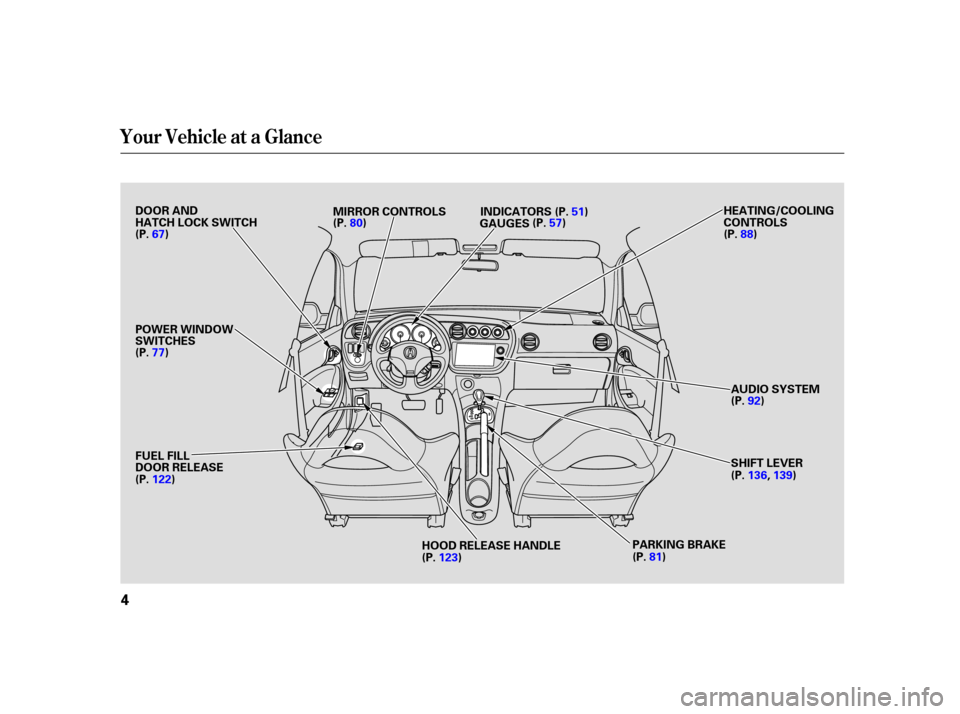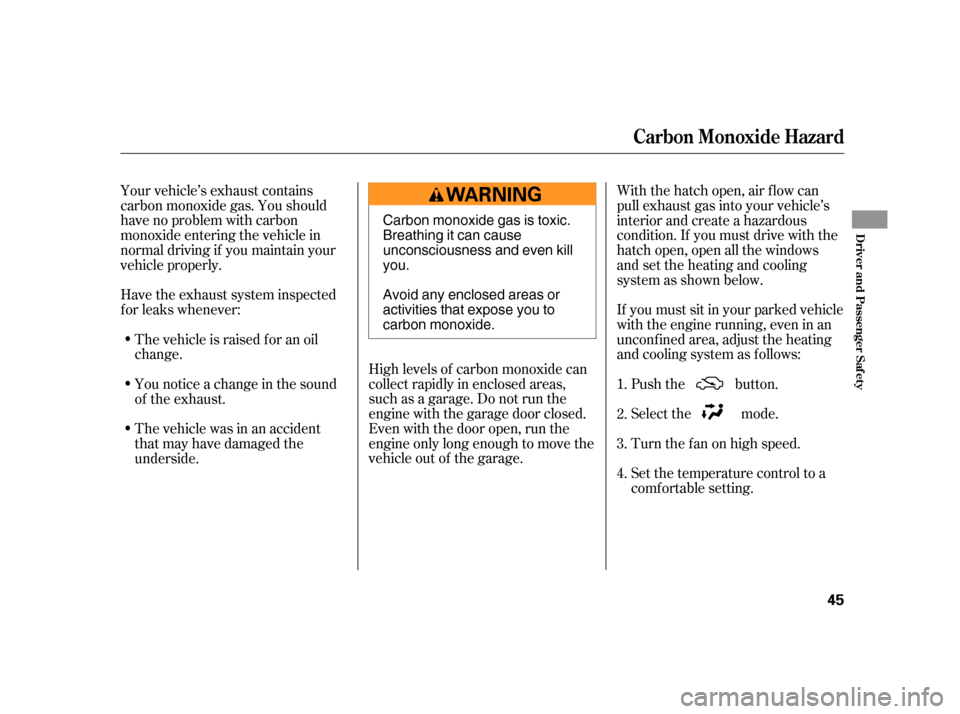cooling Acura RSX 2005 Owner's Manual
[x] Cancel search | Manufacturer: ACURA, Model Year: 2005, Model line: RSX, Model: Acura RSX 2005Pages: 243, PDF Size: 3.42 MB
Page 5 of 243

Your Vehicle at a Glance
4
DOOR AND
HATCH LOCK SWITCH
POWER WINDOW
SWITCHESHEATING/COOLING
CONTROLS
AUDIO SYSTEM
SHIFT LEVER
FUEL FILL
DOOR RELEASE
HOOD RELEASE HANDLE
(P.
67) INDICATORS
GAUGES
MIRROR CONTROLS
(P. 122)
(P.123) (P.
136, 139)
(P.
92)
(P.
88)
PARKING BRAKE
(P.
80) (P.57)(P.
51)
(P.81)
(P.
77)
Page 46 of 243

Your vehicle’s exhaust contains
carbon monoxide gas. You should
have no problem with carbon
monoxide entering the vehicle in
normal driving if you maintain your
vehicle properly.High levels of carbon monoxide can
collect rapidly in enclosed areas,
such as a garage. Do not run the
engine with the garage door closed.
Even with the door open, run the
engine only long enough to move the
vehicle out of the garage.With the hatch open, air flow can
pull exhaust gas into your vehicle’s
interior and create a hazardous
condition. If you must drive with the
hatch open, open all the windows
and set the heating and cooling
system as shown below.
If you must sit in your parked vehicle
with the engine running, even in an
unconf ined area, adjust the heating
and cooling system as f ollows:
Have the exhaust system inspected
f or leaks whenever:
The vehicle is raised f or an oil
change.
You notice a change in the sound
of the exhaust.
The vehicle was in an accident
that may have damaged the
underside. Push the button.
Select the mode.
Turn the f an on high speed.
Set the temperature control to a
comfortable setting.
1.
2.
3.
4.
Carbon Monoxide Hazard
Driver and Passenger Saf ety
45
Carbon monoxide gas is toxic.
Breathing it can cause
unconsciousness and even kill
you.
Avoid any enclosed areas or
activities that expose you to
carbon monoxide.
Page 51 of 243

AT model is shown.
Control L ocations
50
POWER WINDOW
SWITCHES
FUEL FILL
DOOR RELEASEMIRROR CONTROLS
GAUGES HEATING/COOLING
CONTROLS
AUDIO SYSTEM
SHIFT LEVER
HOOD RELEASE HANDLE
DOOR AND
HATCH LOCK SWITCH
INDICATORS
(P. 67) (P.88)
(P. 92)
(P. 136, 139)
(P. 123)
(P.
122)
PARKING BRAKE
(P.
77) (P.
80) (P.
51)
(P. 57)
(P.81)
Page 59 of 243

This shows how much f uel you have.
It may show slightly more or less
than the actual amount. The needle
returns to the bottom after you turn
of f the ignition.This shows the temperature of the
engine’s coolant. During normal
operation, the pointer should rise
from the bottom white mark to about
the middle of the gauge. In severe
driving conditions, such as very hot
weather or a long period of uphill
driving, the pointer may rise to near
the upper white mark. If it reaches
the red (Hot) mark, pull safely to the
side of the road. Turn to page f or
instructions and precautions on
checking the engine’s cooling
system.(Odometer/trip meter message)
If your f uel cap is loose or missing, a
‘‘CHECK FUEL CAP’’ message
appears as text in the odometer/trip
meter display after you start the
engine. Turn the engine of f and
conf irm the f uel cap is installed. If it
is, loosen the cap, then retighten it at
least 3 clicks. When you restart the
engine, the message appears again.
To clear the message, press and hold
the select/reset button until the
message is replaced the odometer/
trip meter display.
If the system still detects a loose or
missing f uel cap, the Malf unction
Indicator Lamp (MIL) comes on.
Turn the engine of f and check or
retighten the fuel cap at least 3 clicks.
The MIL goes out af ter 3 days of
normal driving once the cap is
tightened or replaced. If it does not
go out, have your dealer inspect the
vehicle. For more inf ormation, see
page .
202
205
Fuel Gauge
T emperature GaugeCheck Fuel Cap Indicator
Gauges
58
Avoid driving with an extremely low
f uel level. Running out of f uel could
cause the engine to misf ire, damaging
the catalytic converter.
Page 90 of 243

To use the heating and cooling
system in automatic mode, set the
system as f ollows.Set the f an control dial to AUTO.
Set the mode control dial to AUTO.
Turn the temperature control dial
to the desired temperature.
Select Fresh Air mode by pressing
the Recirculation button. The
indicator in the switch should be
off.
Turn on the A/C by pressing the
button. Pressing the A/C button turns the
air conditioning ON and OFF. The
indicator in the button comes on
when the A/C is ON.
When you turn the A/C of f , the
system cannot regulate the inside
temperature if you set the dial below
the outside air temperature.
With A/C on, use the temperature
control dial to adjust the temperature
of the air f low to a comf ortable
setting.
Air conditioning also removes mois-
ture from the air as it operates. You
canuseittodefogthewindows
quickly in cool or damp weather.
Used in combination with the heater,
it also makes the interior warm and
dry.
To heat or cool the interior f aster,
select Recirculation mode and set
the temperature control dial to the
upper or lower limit. The system
runs on f ull cooling or heating only.
It does not regulate the interior temperature. When the temperature
is set between the lower and upper
limits, the system regulates the
interior temperature to the set value.
TurningthefancontroldialtoOFF
shuts the heating and cooling system
completely off. Keep the system
completely of f only f or short periods.
To keep stale air and mustiness from
collecting, you should have the f an
running at all times.
You can manually set the system
controls f or ventilation, air
conditioning, heating, air f low
direction, and fan speed in various
combinations.
1.
2.
3.
4.
5.
CONT INUED
Vents, Heating, and A/C
Automatic Operation
Manual OperationA ir Condit ioning But t on
Features
89
Page 92 of 243

Theheatingandcoolingsystemhas
temperature sensors next to the
steering column and in the top of the
dashboard. Do not cover the sensors
or spill any liquid on them.
If there is actual frost on the win-
dows, f irst select the Recirculation
mode. If the windows are f ogged,
select the Fresh Air mode. Warmed
air will then flow from the wind-
shield and side def roster vents. The main air f low is directed
to the windshield for faster defrost-
ing or def ogging. To def rost or def og
more quickly, turn the temperature
control dial to maximum. Select , and set the f an speed to
high.
When you select or ,
the A/C turns on automatically to
help dehumidif y the air and def og
the windshield. When you select
another mode, the A/C stays on. If
you do not want to use the A/C in
that mode, press the button to turn it
off.
Vents, Heating, and A/C
T emperature Sensors
Features
91
Page 152 of 243

Many states and Canadian provinces
require special outside mirrors when
towing a trailer. Even if they don’t,
you should install special mirrors if
you cannot clearly see behind you, or
if the trailer creates a blind spot.
Askyourtrailersalesorrental
agency if any other items are
recommended or required f or your
towing situation.The added weight, length, and
height of a trailer will af f ect your
vehicle’s handling and perf ormance,
so driving with a trailer requires
some special driving skills and
techniques.
Foryoursafetyandthesafetyof
others, take time to practice driving
maneuvers bef ore heading f or the
open road, and f ollow the guidelines
discussed below.
Driveslowerthannormalinall
driving situations, and obey posted
speed limits f or vehicles with trailers.
If you have an automatic
transmission, use D position when
towing a trailer on level roads.
When preparing to tow, and bef ore
driving away, be sure to check the
f ollowing:
The vehicle has been properly
serviced, and the tires, brakes,
suspension, cooling system, and
lights are in good operating
condition.
All weights and loads are within
limits.
Thehitch,safetychains,andany
other attachments are secure.
All items in or on the trailer are
properly secured and cannot shif t
while you drive.
Your vehicle tires and spare are
properly inf lated, and the trailer
tires and spare are inflated as
recommended by the trailer
maker.
CONT INUED
Towing a Trailer
A ddit ional T owing Equipment
T owing Speeds and GearsDriving Saf ely With a T railer
Pre-T ow Checklist
Driving
151
Page 166 of 243

CONT INUED
Let the engine run f or several
minutes, then check the drain bolt
and oil f ilter f or leaks.
Turn of f the engine, let it sit f or
several minutes, then check the oil
level on the dipstick. If necessary,
add more oil. Replace the engine oil f ill cap.
Start the engine. The oil pressure
indicator should go of f within 5
seconds. If it does not, turn of f the
engine and check your work.Always use Honda All Season
Antif reeze/Coolant Type 2. This
coolant is pre-mixed with 50 percent
antif reeze and 50 percent water.
Never add straight antifreeze or
plain water.
If Honda antif reeze/coolant is not
available, you may use another
major-brand non-silicate coolant as a
temporaryreplacement.Makesureit
is a high-quality coolant
recommended f or aluminum engines.
Continued use of any non-Honda
coolant can result in corrosion,
causingthecoolingsystemto
malf unction or f ail. Have the cooling
system f lushed and ref illed with
Honda antif reeze/coolant as soon as
possible.
If the coolant level in the reserve
tank is at or below the MIN line, add
coolant to bring it up to the MAX line.
Inspect the cooling system f or leaks.
7.
8.
9.
A dding Engine Coolant
Changing the Oil and Filter, Engine Coolant
Maint enance
165
MAX
MIN
Improper disposal of engine oil can be
harmf ul to the environment. If you
change your own oil, please dispose of
the used oil properly. Put it in a sealed
container, and take it to a recycling
center. Do not discard it in a trash bin
or dump it on the ground.
Page 167 of 243

If the reserve tank is completely
empty, you should also check the
coolant level in the radiator.When the radiator and engine are
cool, relieve any pressure in the
cooling system by turning the
radiator cap counterclockwise,
without pressing down.
Remove the radiator cap by
pushing down and turning
counterclockwise.Do not add any rust inhibitors or
other additives to your vehicle’s
cooling system. They may not be
compatible with the coolant or
engine components.Pour coolant into the reserve tank.
Fill it to half way between the MAX
and MIN marks. Put the cap on
the reserve tank. Put the radiator cap on, and
tighten it fully. Pourthecoolantslowlyand
caref ully so you do not spill. Clean
up any spill immediately; it could
damage components in the engine
compartment. The coolant level should be up to
the base of the f iller neck. Add
coolant if it is low.
2. 1. 3.
4.
5.
Engine Coolant
166
RADIATOR CAP
Removing the radiator cap
while the engine is hot can
cause the coolant to spray out,
seriously scalding you.
Always let the engine and
radiator cool down before
removing the radiator cap.
Page 180 of 243

If your seat belts get dirty, use a sof t
brush with a mixture of mild soap
and warm water to clean them. Do
not use bleach, dye, or cleaning
solvents. Let the belts air dry bef ore
you use the vehicle.
Dirt build-up in the loops of the seat
belt anchors can cause the belts to
retract slowly. Wipe the insides of
the loops with a clean cloth
dampened in mild soap and warm
water or isopropyl alcohol.The driver’s f loor mat that came
with your vehicle hooks over the
f loor mat anchor. This keeps the
f loor mat f rom sliding f orward and
possibly interf ering with the pedals.
If you remove the driver’s f loor mat,
make sure to re-anchor it when you
putitbackinyourvehicle.This f ilter removes the dust and
pollenthatisbroughtinfromthe
outside through the heating and
cooling system. If you use an aftermarket floor mat,
make sure it f its properly and that it
canbeusedwiththefloormat
anchor. Do not put additional f loor
mats on top of the anchored mat.
Have your dealer replace this filter
every 30,000 miles (48,000 km)
under normal conditions. It should
be replaced every 15,000 miles
(24,000 km) if you drive primarily in
urban areas that have high
concentrations of soot in the air, or if
the airflow from the heating and
cooling system is less than usual.
Floor Mats
Dust and Pollen Filter
Cleaning the Seat Belts
Cleaning the Seat Belts, Floor Mats, Dust and Pollen Filter
Maint enance
179
LOOP